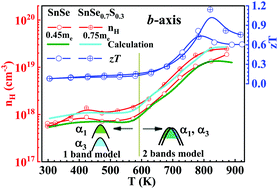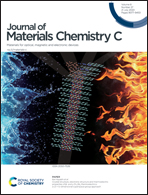The unique evolution of transport bands and thermoelectric performance enhancement by extending low-symmetry phase to high temperature in tin selenide†
Abstract
Thermoelectric conversion is a promising route to convert heat into electricity. In this process, phase transition may induce an unexpected consequence under certain conditions. In this work, we find that the extension of a low-temperature phase with a low-symmetry lattice structure, which has excellent electrical properties and low thermal conductivity, enhances the thermoelectric performance via a sulfur solid solution in SnSe-based thermoelectric materials. Peak zT values of 1.14 and 0.94 are obtained along the b- and c-axes of the SnSe0.7S0.3 single crystal at 820 K, which are about 41% and 27% higher than those of the undoped SnSe single crystals, by extending the low-symmetry structure in this experiment. Band structure calculations and angle-resolved photoemission spectroscopy (ARPES) suggest that the unique evolution of the transport bands with temperature in the SnSe-based materials should be responsible for the abnormal electrical behavior and large Seebeck coefficient in the low-symmetry structure.



 Please wait while we load your content...
Please wait while we load your content...